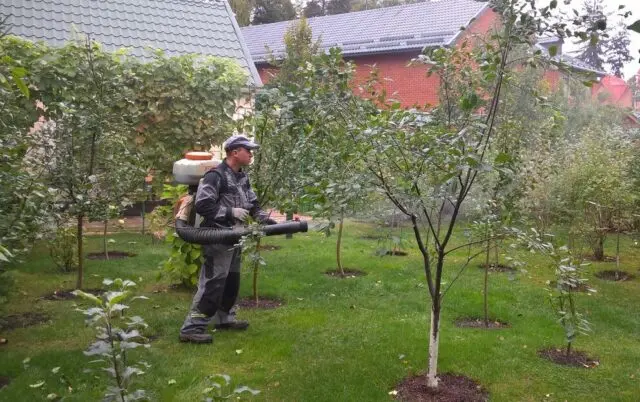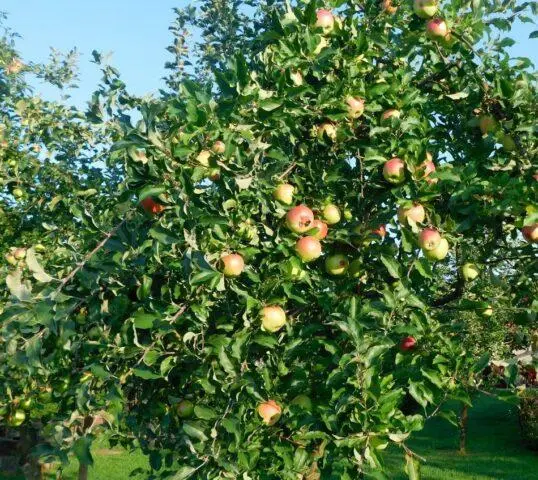Contents
Soot fungus on an apple tree is a rather dangerous infectious disease caused by microscopic organisms. Outwardly, it manifests itself as a black coating resembling soot. For treatment, it is necessary to use not only antifungal drugs (fungicides), but also insect repellents (insecticides). For the prevention of the disease, the use of folk remedies is permissible.
Causes of black plaque on the leaves, branches and trunk of an apple tree
Soot fungus is an infectious pathology that affects apple trees and other fruit crops. The disease is ubiquitous. The following reasons contribute to its development:
- If the apple tree is affected by aphids, suckers, bark beetles and other insects that leave sugary mucus, the fungus feeds on these secretions and penetrates into the tissues of the plant.
- Warm and humid weather is the optimal environment for spore germination.
- Soot fungus is activated by excessive watering, when the soil and air around are too humid.
- Contributes to the reproduction of the pest and shading, as well as a dense crown, the lack of regular pruning.
The described reasons lead to the fact that a black coating appears on a young apple tree. If the trees have not previously suffered from this infection, they can cope with it, especially if treatment is started as early as possible. If the seedling is initially affected by spores, it will begin to lag behind in development, and may die over time.
Signs and development
The main sign of soot fungus is the appearance of a black coating on different parts of the apple tree:
- bark;
- shoots and branches;
- leaves;
- fruits, including immature ones.
In appearance, this plaque resembles soot or ash, which is why the disease got its name. Unlike scab, the affected areas have different sizes and shapes, they are easily erased. The leaves gradually dry up and die off, and the fruits become small and covered with an ugly bloom.
Sooty fungus attacks apple trees with wounds on the bark, with damage due to recent pruning. In these places, plant juices are released, which feed on the pathogen. It multiplies rapidly, producing numerous hyphae that coat the bark of the tree and clog pores.

Apple trees affected by soot fungus require treatment
As they develop, fungal microorganisms feed on honeydew – the sweet secretions of aphids and other insects, as well as plant juices of the apple tree itself. This leads to adverse consequences:
- the pores are clogged with a viscous liquid;
- disrupted tissue metabolism, respiration of leaf cells;
- the process of photosynthesis stops;
- tissues die;
- the apple tree becomes less winter hardy.
How to deal with soot fungus on an apple tree
There are many ways to deal with black bloom on an apple tree. The most effective option is to treat with fungicides. It is also recommended to use folk remedies and mechanical methods.
Fungitsidы
Fungicides are special antifungal agents. They are produced in the form of solutions with chemicals or bacterial strains. The main drugs against soot fungus:
- “Fitosporin”;
- “Bordeaux liquid”;
- “Strobe”;
- “Score”;
- “RAW”;
- “Abiga Peak”;
- “Respect 25%” and others.
When preparing the solution, the dosage must be carefully observed. Waiting times should also be taken into account – the minimum period from the day of the last spraying to harvest. For many drugs, it is 15-30 days. Therefore, the procedure is planned in advance.

“Strobi” is one of the most effective fungicides against soot fungus
Insekticidы
Since the spread of the disease on an apple tree is often associated with insects (aphids, suckers, bark beetles, and others), it is necessary to treat with insecticides simultaneously with the use of fungicides. The most effective means are:
- “Biotlin”;
- “Decis”;
- “Fitoverm”;
- “Aktara”;
- “Inta-Vir”;
- “Agravertin”;
- “Fufanon”; and others.
Mechanical methods
If a black plaque appears on the trunk of an apple tree, treatment can be carried out mechanically. Affected leaves are removed. Also cut off the shoots. The trunk and skeletal branches are carefully cleaned to a healthy place. After that, they are washed with solutions of special preparations:
- copper or iron sulfate;
- caustic soda.
If more than two weeks are left before harvest, fungicides can be used. If the apples are almost ripe, then after cleaning from the soot fungus, the affected areas are washed with baking soda (150 g per 10 l) with laundry soap shavings (100 g per the same volume). After harvesting, you need to repeat the processing. They use not only folk remedies, but also fungicides.
Folk remedies
Folk remedies can only be considered as an additional method of treatment. They are quite effective in the early stages of damage, for prevention, while being used with fungicides. Experienced gardeners recommend using the following recipes:
- Processing an apple tree with fresh beer – “live” (on tap) or homemade. They take a clean rag or gauze, moisten it in a drink and wipe the affected branches, foliage and fruits.
- Treatment with an aqueous solution of ethyl alcohol with a concentration of 60%. The method of application is similar – wiping the branches, fruits and foliage of an apple tree with a damp cloth.
- To combat soot fungus, a solution of copper sulfate (5 g) with laundry soap (150 g) is used. Both components are dissolved in 10 liters of water and mixed thoroughly. Then proceed to spraying the apple tree.
- Take dry potato tops (800 g) and pour 10 liters of warm water, leave for four hours. Then strain and add 40 ml of liquid soap and proceed with the treatment of the apple tree from the soot fungus.
- You can grind 400 g of dandelion roots and leaves, pour 10 liters of warm water and leave for three hours, then strain and spray the crown. You can start work immediately after bud break, at the end of flowering (for prevention), when the first signs of pathology appear.

Treatment with folk remedies helps only in the early stages of the development of the disease.
Increased immunity
When a black coating appeared on the apple tree, this already indicates the development of soot fungus. To prevent the progression of the disease, it is recommended to follow measures to increase the immunity of the plant. For this, apple trees are regularly fed with mineral fertilizers. They should be applied as a root method (watering the near-stem circle):
- Ammonium nitrate – take granules in the amount of 30 g and dissolve in 10 liters. Watering is carried out annually in early spring, when the snow melts.
- Ammonium sulfate – a solution of 20 g per 10 liters. Water the near-stem circle in early spring. Can be used simultaneously with ammonium nitrate.
- Potassium chloride against soot fungus – in April, watered with a solution of 20 g per 20 liters.
- Potassium salt – you need 20 g per 30 liters. Watering is carried out in the fall.
- Potassium sulfate – 50 g per 10 liters. The tool is effective in the autumn.
- Urea (100 g per 10 l) and nitrophoska (50 g per 10 l) are suitable for root application. Use in autumn.
To increase the resistance of the apple tree to soot fungus and other pests, treatment with special preparations should be carried out (one to choose from):
- “Stimix Concentrate” – 10 ml is dissolved in 100 liters. Water apple trees after harvest.
- “Stimix Standard” – 50 ml per 10 liters. Processing is done up to seven times per season with breaks of 14 days.
- “Stimix Fitostim” – 50 ml per 10 liters, spraying is carried out once a month. 3-4 treatments per season are enough.
- “Baikal EM-1” – the drug is diluted in a standard bucket of water (10 ml per 10 l). Do three treatments per season with an interval of 1-1,5 months.
- “Shining-1” – dissolve 10 ml in 10 liters and water the apple tree in April.
preventive measures
A black coating of soot fungus on the bark of an apple tree is a symptom of a rather dangerous disease that can lead to the death of a tree. Eliminating the consequences of this pathology is much more difficult than preventing it. Therefore, experienced gardeners recommend following basic preventive measures:
- In the spring, regularly do sanitary pruning, and then treat the apple tree with a fungicide.
- Always observe the watering rate, especially in cloudy and rainy summers.
- Be sure to thin out the crown.
- When planting apple trees, place seedlings at a distance (at least 4 m).
- Throughout the season, use special means to increase immunity.
- For the prevention of soot fungus in the fall, after pruning, carefully dig up the near-trunk circle, remove all foliage and other residues, take them away and burn them.

In order for the apple tree to be healthy, it is necessary to carry out preventive treatments every spring.
Conclusion
Soot fungus on an apple tree can lead to a decrease in yield, winter hardiness of a tree and immunity to other diseases. Often, the infection spreads along with aphids, suckers and other pests. Therefore, for treatment, several treatments with fungicides and insecticides are necessary. It is equally important to take preventive measures. They will prevent the spread of soot fungus and other dangerous pathologies.









